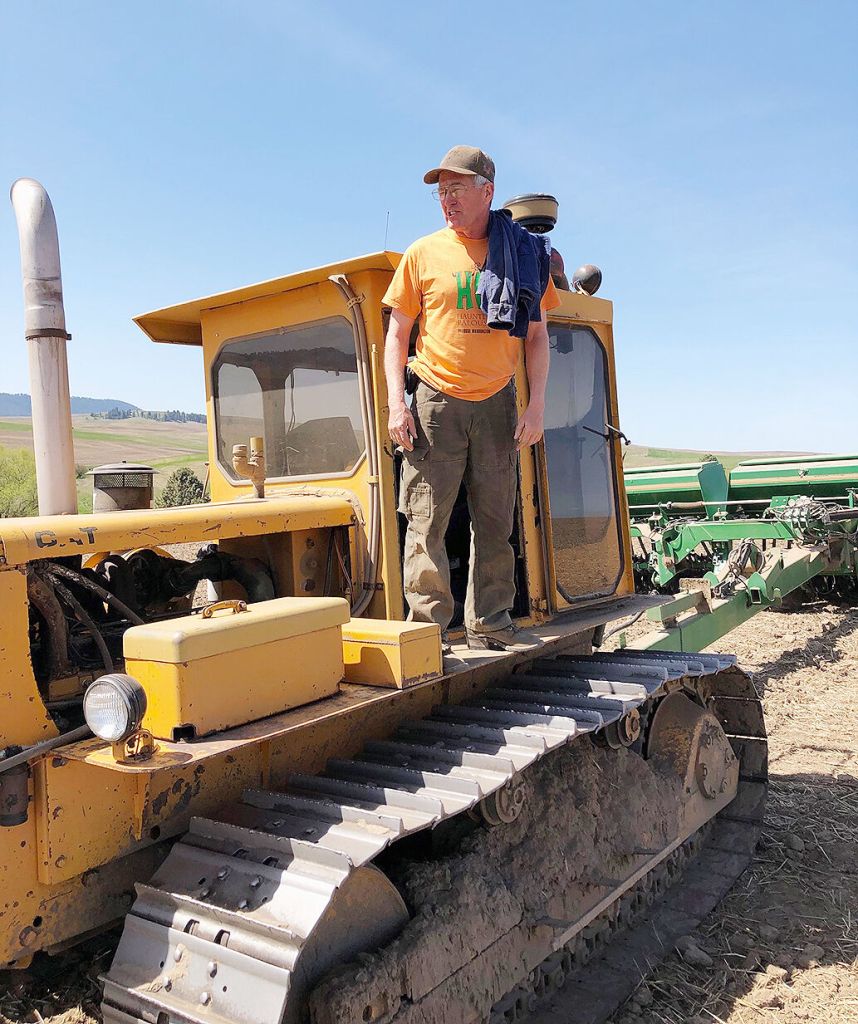Boosting barley: New WSU malt quality laboratory could increase barley acreage, profits
Published 7:00 am Thursday, October 8, 2020

- Ben Barstow of Palouse, Wash., is one of two farmers who represent barley on the Washington Grain Commission. He is the commission’s new chairman.
PULLMAN, Wash. — On a sunny September day, program manager Max Wood maneuvered a pint-size Wintersteiger Classic Plus combine across a plot of malting barley that is part of Washington State University’s new research efforts.
Trending
It was the first day of putting the new combine through its paces at the university’s Spillman Agronomy Farm, where different varieties of barley are studied.
Manufactured in Austria, it’s one of the first combines of its type to be delivered to the U.S., barley breeder Bob Brueggeman said.
Compared to the larger combines farmers use to harvest their grain crops across the state, this is a much smaller machine, designed to harvest experimental plots grown for research.
Trending
It’s also been outfitted to measure yields and moisture in the field, enabling Brueggeman’s crew to save time and effort. Without it, they would have to take the barley to the seed house to clean and weigh.
The $200,000 combine was a key item on Brueggeman’s wish list when he negotiated to take over as WSU’s barley breeder in July 2019.
Brueggeman — with the backing of the Washington Grain Commission and WSU leaders — is betting that they can make barley a profitable option for the state’s farmers again.
‘Quality, quality, quality’
When Brueggeman was hired as the barley breeder, he called it his “dream job.”
Now, he’s establishing a state-of-the-art malt quality laboratory, which is slated to begin operations in December.
“First we’re going to focus on quality, quality, quality, and hopefully get more material in the field that has the quality, (then) we can select for the farmer traits — yield, standability, stature,” Brueggeman said.
Varieties must meet the malting requirements of the American Malting Barley Association.
In making malt, barley is steeped in water until it reaches a high moisture content. The barley is then germinated. The sprouting activates enzymes, which convert starches into sugars for brewing beer, according to the malting barley association. The barley is then dried.
“Malt barley breeding is a numbers game,” said Scott Heisel, vice president and technical director of the malting barley association. “Anytime you increase the capacity for testing, you’re improving your chances of coming up with a new variety that will be adapted for the growers in your area, and for the industry to utilize.”
The laboratory will allow Washington farmers to produce premium malt barley that malting companies will seek, Brueggeman wrote to the commission in his proposal.
The grain commission provided $233,500 to help fund the effort.
Previously, WSU’s breeding program focused primarily on feed barley for livestock.
Brueggeman’s program would also focus on “all malt” varieties to meet the needs of craft brewers and distillers.
Two of the major bottlenecks in the program were getting data to select early generation barley lines and determining whether advanced breeding lines meet quality standards.
The laboratory will allow Brueggeman to streamline efforts in the field and in the analyses required for his research.
“We have great wheat quality coming out of the Pacific Northwest — the same thing would be true for barley,” he said.
Making barley pay
Right now, industry leaders agree, the biggest factor limiting barley production is the low price compared to other crops grown in the region, particularly spring wheat.
Feed barley is priced at $130 per ton, or $2.83 per bushel minus the cost of transportation. Soft white wheat sells for about $5.65 a bushel on the Portland market, or nearly $208 per ton.
Either malt barley or food barley would bring higher prices than feed barley.
Barley used to be a much more common crop.
In 1985, Washington barley production peaked at 1.18 million acres. This year, 97,000 acres were harvested in the state.
Farmers will plant more barley if it makes them more money, said Mary Palmer Sullivan, vice president of the grain commission.
She often hears from growers who praise barley’s benefits to the soil and to the following wheat crop.
“There’s a lot of farmers that would love to get back into it, but because of price, they don’t,” she said. “The farmers aren’t just going to grow barley for the fun of it. They want to make money.”
Brueggeman says barley provides “ecosystem services” in the soil, calling it “soil conditioning.” He hears anecdotally from growers about barley’s benefits to the following crop, he said.
Sullivan knows her barley. She joined what was then the Washington Barley Commission in 1988. It merged with the Washington Wheat Commission in 2009 to become the grain commission.
She is affectionately known in the industry as the “Barley Babe,” although she doesn’t know where that nickname originated. In 2019, former WSU barley breeder Kevin Murphy named a new spring barley variety Palmer after her.
“Ultimately, I think we’ve changed our outlook on barley,” Sullivan said. “Barley is no longer just a feed crop. It’s a specialty crop for food and malt. That’s what creates value.”
Difficult decisionEven with all the benefits the new laboratory will provide, deciding to fund it was a difficult decision, said Ben Barstow, a Palouse, Wash., farmer who represents barley on the grain commission board.
The board had to justify dipping “so deeply into our scanty reserves to fund this thing,” Barstow said.
It decided the laboratory is exactly what a reserve is for, he said.
“When something like this does come along, we have the ability to take advantage of it,” he said.
The grain commission representatives also agreed that Brueggeman is the man to lead the charge.
“We have an excellent breeder in place,” said Kevin Klein, an Edwall, Wash., farmer and the other barley representative on the board.
Winter barley
Most barley lines previously bred in WSU’s program were spring varieties, Brueggeman said. He’ll work with Oregon State University barley breeder Patrick Hayes, who will provide access to his winter malt barley materials.
Winter varieties would mean higher yields, incorporate early-season moisture and avoid some diseases common in spring varieties, Brueggeman said. It wouldn’t compete with winter wheat, but could still be used in a rotation with it.
A winter barley with high survivability and higher yields would make it attractive, even as feed.
“The price may not change, but at least it would be profitable,” Brueggeman said.
New home for malt barley?
Between 1.25 million and 1.5 million acres are devoted to malt barley in the U.S., the malting barley association’s Heisel said. The majority of the acres are grown under contract for specific companies.
An increase in suitable areas for growing barley is always welcome, Heisel said.
“We don’t have a lot of varieties that are really well-suited to the conditions in Washington right now,” he said. “Increasing the number of varieties adapted to that region would certainly have a potential to increase acres.”
Disease is another factor.
In the Midwest, farmers primarily raise corn and soybeans. If more farmers pick those crops and cut back on barley, that could allow Pacific Northwest farmers to make up the difference.
Also, as corn production encroaches on malting barley production areas such as Central Montana, problems with barley scab increase, said Barstow, the Palouse farmer.
“The best way to control it is to not grow barley where you have the disease present,” he said. “The inland Pacific Northwest here, where we’re not growing corn, is one of the last major barley production areas that would be possible to grow malt barley without much danger of scab.”
Without Brueggeman’s laboratory, adapting barley to Washington would be slow going, Barstow said.
Klein, the Edwall farmer, said the industry is trying to set up the region to produce more barley, but the market would have to remain sustainable at a price comparable to wheat.
“In my opinion, we don’t have the infrastructure to move the malt barley,” he said.
That will come in time with Brueggeman’s laboratory, although not necessarily quickly, he said.
The region has the malting capacity, said Sullivan of the grain commission.
“Do we have the ability to ship eastward? Some people would say no, but I’ve heard it can be done,” she said.
Brueggeman also said a Northwest-produced barley could gain traction in export markets, and noted that some malt facilities are beginning to close in the Midwest.
He pointed to early predictions of world malt barley shortages in regions with drought or disease problems due to excessive rains. Other areas with adequate rain would also likely see increased disease pressure.
Barley farmers in the Midwest face more diseases, which Brueggeman saw firsthand while working there as a barley pathologist.
“We had to focus so much time trying to bring the quality up by managing disease,” he said. “Here, we do have adequate moisture to get good malt quality, but we also have an environment that’s not conducive to a lot of disease.”
Hopefully, the Pacific Northwest can take up some of the slack, Brueggeman said.
Many of the region’s craft brewers are interested in locally grown ingredients such as hops and barley, the malting barley association’s Heisel said.
Eventually, Barstow expects to see more barley custom-grown for small or mid-sized breweries, which would have the barley malted at a small malt house.
Heart-healthy
Finding the value in malt and food barley has always been possible, Sullivan said. It’s just one of those things that’s never quite caught on like other food trends.
“I know in my heart — no pun intended — that it’s a heart-healthy food and that it’s good for you,” she said. “You can’t force it, but at some point, you just hope somebody, like some celebrity, will endorse it and everyone will follow it and love it. Sometimes it just takes that special acknowledgement or recognition to make people notice it.”
Sullivan would like to see Washington farmers eventually raising 300,000 to 500,000 acres of barley.
The grain commission is dedicated to WSU’s barley program, and committed to creating value for growers, she said.
It takes 10 to 12 years to breed a new barley variety.
“We’re not going to be able to turn this ship on a dime,” Sullivan said. “We’re going to have to put a lot of faith, dedicate some time and maybe a little bit of prayer to make this happen.”









